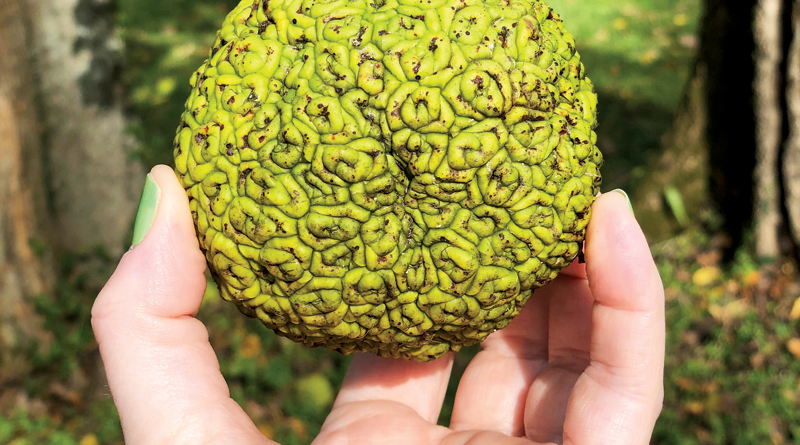OSAGE ORANGE AND WILDLIFE

Osage orange is a thorny deciduous tree that grew in Osage Indian territory, northern Texas, southeast Oklahoma and Arkansas. The fruits are round, baseball size to softball size and rough, like oranges. They’re green until ripe, then orange.
Leaves of Osage orange trees are bright green in spring and summer and turn bright yellow in fall. They’re oval shaped, pointed on each end. These trees grow forty to fifty feet tall.
Young Osage orange trees are like dense bushes, thickets of leaves and thorns that kept out foxes, coyotes and wolves, cattle and horses and sheep. Recognizing this, farmers planted Osage oranges in rows around their fields and clipped them like hedges every two or three years. They were living fences, once scattered through farm country in the Midwest, south and northeast. While impenetrable to larger animals, Osage oranges fence rows were safe havens for smaller mammals and birds.
Osage orange is the English name for this plant. French-Americans called it bois d’arc, pronounced bwaDARK. Indians used the wood of Osage Orange, which is strong, flexible and yellow, to make bows and it was also called bowwood.
This is a plant of many names. It is also called bowdark and bodock, mispronunciations, I believe, of bowwood. Other names are bodock and bodock. Still others are mock orange and hedge apple. It has also been called horse apple. After the fruit has fallen it turns dark and does look somewhat like horse droppings.
Osage orange fruit is inedible. Even squirrels and other animals, including birds won’t eat the fruit. But the seeds are edible and squirrels and other small mammals, bobwhite and other birds tear into the fruit to get the seeds.
Osage orange fences, living fences, are gone now, replaced by barbed wire. Now even the barbed wire is gone from most fields. Farmers have a little more land to cultivate and plow and plant to roads and lanes, some even turning their tractors and other equipment around in the roads.
Osage orange fences were nearly gone when I was a boy but most cultivated fields were still fenced with barbed wire. After the crops had been harvested, particularly corn, farmers turned cattle into the fields to feed on scattered ears of corn and other grain dropped during the harvest.
Now the fences, too, are gone. And the birds that nested in the fence rows have declined greatly in number, as I wrote in my last article. One of the reasons for the decline in bird numbers is loss of habitat. That being the case, the decline in bird numbers began earlier than most reports. An article in the recent issue of the Cornell University Living Bird, titled Vanishing Birds, stated that birds of North America have declined overall by nearly thirty percent in the last fifty years. The article further noted that grassland birds have declined by as much as seventy percent. That’s in the last fifty years. What about the previous fifty years, the time of the elimination of Osage orange fence rows, then of barbed wire fence rows?
It isn’t just birds that have declined. Mammals, rabbits and deer, woodchucks, raccoons and opossums have also declined. I haven’t seen any figures for decline of mammals but there aren’t as many dead animals on the roads. That would be a good thing if it wasn’t, I’m sure, that the reason there aren’t as many dead animals on the roads is that there just aren’t as many rabbits and deer, woodchucks, raccoons and opossums.
We’ll never have Osage orange fencerows as there once were. Nor will we have barbed wire fences around fields as there were when I was a boy. Nor, unfortunately in my opinion, will we ever have as many birds or other animals as there were.
- Birds As Weather Forecasters – Life In The Outdoors - December 17, 2021
- Rare Bird Spotted In Indiana – Life In The Outdoors - October 8, 2021
- MY EXPERIENCE WITH DEER – Life In The Outdoors - July 30, 2021


